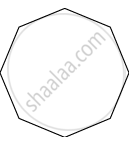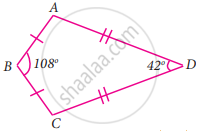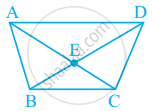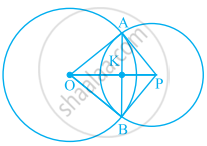Advertisements
Advertisements
प्रश्न
In a trapezium ABCD, side AB is parallel to side DC. If ∠A = 78° and ∠C = 120. find angles B and D.
उत्तर
∵ AB || DC and BC is transversal
∴∠B and ∠C, ∠A and ∠D are Cointerior angles with their sum = 180°
i.e. ∠B + ∠C = 180°
⇒ ∠B + 120° = 180°
⇒ ∠B = 180° – 120°
⇒ ∠B = 60°
Also ∠A + ∠D = 180°
⇒ 78° + ∠D = 180°
⇒ ∠D = 180° – 78°
∠D = 102°
APPEARS IN
संबंधित प्रश्न
In a quadrilateral, define of the following Interior .
In a quadrilateral, define of the following Exterior .
The three angles of a quadrilateral are respectively equal to 110°, 50° and 40°. Find its fourth angle.
If the sum of the two angles of a quadrilateral is 180°. What is the sum of the remaining two angles?
Determine the number of sides of a polygon whose exterior and interior angles are in the ratio 1 : 5.
In the given figure, PQRS is an isosceles trapezium. Find x and y.

Complete the following statement by means of one of those given in brackets against each:
If opposite angles of a quadrilateral are equal, then it is necessarily a ....................
If ABCD is a rectangle with ∠BAC = 32°, find the measure of ∠DBC.
In quadrilateral ABCD, side AB is parallel to side DC. If ∠A : ∠D = 1 : 2 and ∠C : ∠B = 4 : 5
(i) Calculate each angle of the quadrilateral.
(ii) Assign a special name to quadrilateral ABCD
Observe the figure below and find out their name.

One angle of a hexagon is 140° and the remaining angles are in the ratio 4 : 3 : 4 : 5 : 4. Calculate the measures of the smallest and the largest angles.
In the quadrilateral ABCD, AB = BC and AD = DC Measure of ∠BCD is
If APB and CQD are two parallel lines, then the bisectors of the angles APQ, BPQ, CQP and PQD form ______.
The number of obtuse angles in figure is ______.
A pair of opposite sides of a trapezium are ______.
The number of right angles in a straight angle is ______ and that in a complete angle is ______.
In given figure, name any two angles that appear to be obtuse angles.
In given figure, What is BD – BE?
Using the information given, name the right angles in part of figure:
OP ⊥ AB
